Wuyi Mountains: The Perfect Destination for Eco-Tourism Enthusiasts
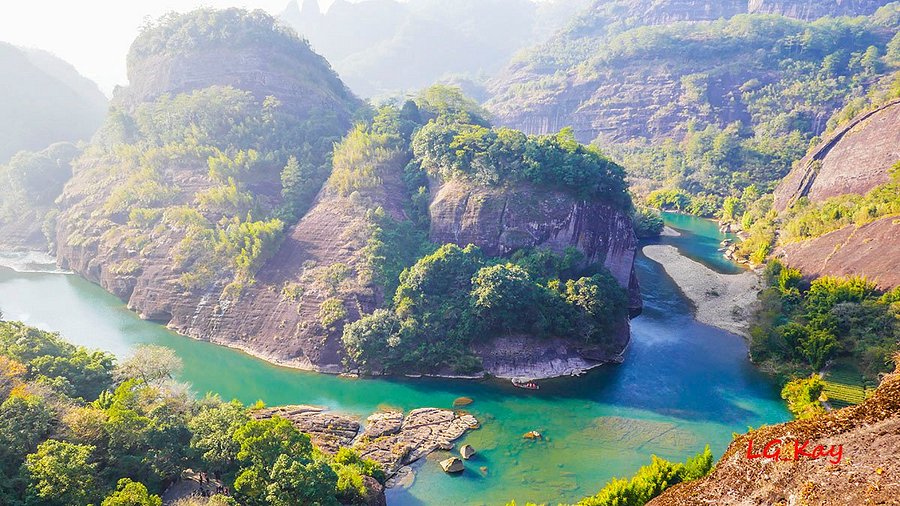
An Essential Guide to Visiting Wuyi Mountains
Nestled between the serene landscapes of Fujian and Jiangxi provinces, the Wuyi Mountains stand as a testament to nature’s artistry, boasting a rich tapestry of rugged peaks, lush valleys, and crystal-clear rivers. This UNESCO World Cultural and Natural Heritage Site captivates travelers with its breathtaking scenery and profound cultural significance, making it a must-visit destination for anyone yearning to explore the wonders of China.
The Wuyi Mountains are not just a feast for the eyes; they are a sanctuary for nature lovers, hikers, and tea enthusiasts alike. With deep canyons carved by time, enchanting waterfalls cascading down rocky cliffs, and an array of rare flora and fauna, the region invites you to immerse yourself in its tranquil beauty. Whether you choose to glide along the meandering Nine-Bend Creek on a bamboo raft, conquer the peaks for panoramic views, or sip the world-renowned Wuyi Rock Tea amidst the verdant tea plantations, each experience promises to be unforgettable.
As you prepare for your journey to this enchanting mountain range, you’ll discover that every season unveils a new facet of its charm—bright blossoms in spring, lush greenery in summer, vibrant autumn leaves, and misty, ethereal landscapes in winter.
Join us as we delve into the essential guide to visiting the Wuyi Mountains, where adventure, serenity, and culture seamlessly intertwine, waiting to be explored.
In This Guide
- An Essential Guide to Visiting Wuyi Mountains
- The Rich History and Legends of Wuyi Mountains
- Main Highlights: What You Absolutely Can’t Miss
- Planning Your Visit: A Practical Guide
- Tickets: Prices, Booking, and Tips
- How to Get There: A Complete Transportation Guide
- Local Cuisine and Accommodation Nearby
- Frequently Asked Questions
- Final Thoughts on Your Trip
The Rich History and Legends of Wuyi Mountains
The Wuyi Mountains, a UNESCO World Cultural and Natural Heritage Site, are steeped in rich history and captivating legends that weave together the narrative of this breathtaking region. Located in the Fujian and Jiangxi provinces of China, these majestic mountains have served as a cradle of Chinese culture and spirituality for thousands of years.
Ancient Civilizations and Cultural Significance
The history of the Wuyi Mountains dates back to ancient times, with archaeological evidence suggesting human habitation as early as 2000 BC. This area has long been revered for its natural beauty, which inspired poets, painters, and philosophers throughout Chinese history. The mountains are often associated with Taoism and Confucianism, serving as a sanctuary for scholars seeking spiritual enlightenment and intellectual growth.
One of the most significant historical sites within the Wuyi Mountains is Wuyi Palace, a Taoist temple built during the Song Dynasty (960-1279 AD). This temple stands as a testament to the region’s religious importance and is a pilgrimage site for devotees. The intricate architecture and serene surroundings of Wuyi Palace draw visitors, providing a glimpse into the spiritual heritage that permeates the mountains.
The Legend of Da Hong Pao Tea
Among the many legends surrounding the Wuyi Mountains, the tale of Da Hong Pao tea stands out. Da Hong Pao, or “Big Red Robe,” is one of China’s most famous teas, known for its rich flavor and health benefits. According to local legend, during the Ming Dynasty (1368-1644 AD), an emperor fell ill while traveling through the region. His health was restored by the tea brewed from the leaves of the Da Hong Pao trees, which were said to be over a thousand years old. In gratitude, the emperor sent red robes to cover the original tea bushes as a mark of honor. Today, these legendary tea trees are protected, and their leaves continue to be harvested to produce this esteemed beverage, further enriching the cultural tapestry of the Wuyi Mountains.
The Mystique of the Peaks and Caves
The peaks and caves of the Wuyi Mountains are not just geological wonders; they are also steeped in myth and folklore. For instance, Tiger Hissing Peak is named for the sounds that echo through its rugged cliffs, reminiscent of a tiger’s roar. Local lore claims that a deity once rode a tiger through the mountains, lending an air of mystique to this striking landscape.
Another enchanting feature is the Water Curtain Cave, the largest cavern in the area. This cave is said to have been the dwelling place of various deities, and its eerie echoes and flowing waters have inspired countless tales of spirits and supernatural beings. The combination of natural beauty and legends creates an atmosphere that captivates visitors, inviting them to explore deeper into the history of this enchanting region.
A Cultural Hub
Throughout history, the Wuyi Mountains have served as a cultural hub, influencing various aspects of Chinese life. The region is renowned for its traditional tea culture, with tea plantations dotting the landscape and offering visitors an opportunity to experience the art of tea-making firsthand. The mountains have also been a source of inspiration for many Chinese poets and artists, who have immortalized their beauty in countless works.
As travelers explore the Wuyi Mountains, they walk in the footsteps of scholars, emperors, and tea artisans, each leaving their mark on this remarkable landscape. The intertwining of history and legend continues to resonate, making the Wuyi Mountains not only a destination for natural beauty but also a journey through time and culture.
In summary, the Wuyi Mountains are a living tapestry of history and myth, where the echoes of the past harmonize with the serene beauty of nature, creating an unforgettable experience for those who venture into this remarkable part of China.
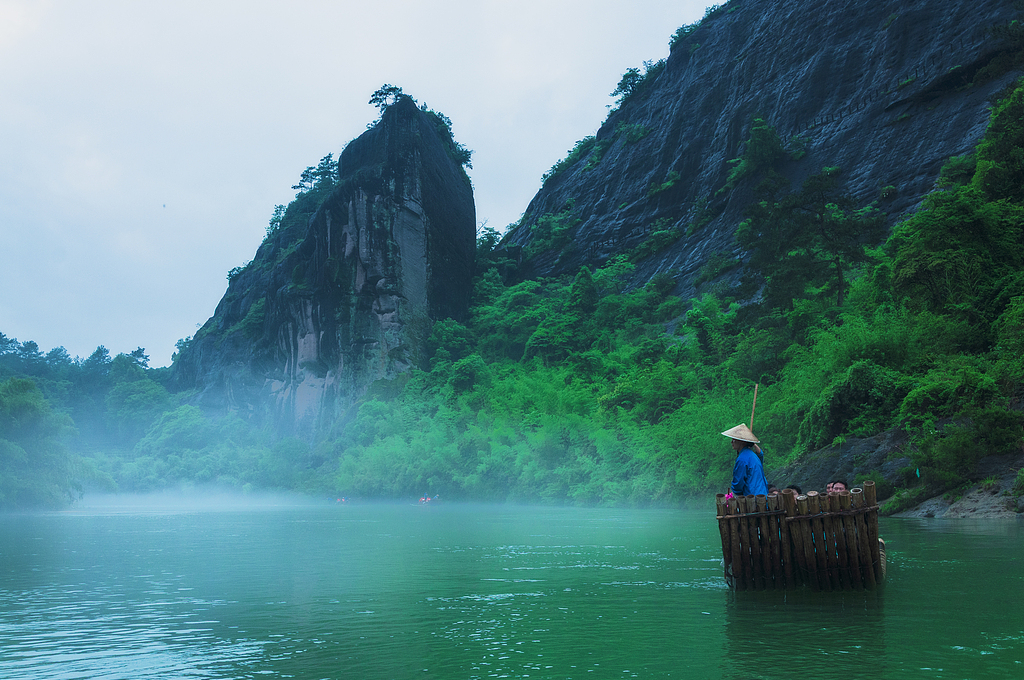
Wuyi Mountains.
Main Highlights: What You Absolutely Can’t Miss
The Wuyi Mountains, a UNESCO World Cultural and Natural Heritage Site, are an enchanting blend of stunning landscapes, rich biodiversity, and cultural treasures. Nestled between Wuyishan City in Fujian Province and Wuyishan Town in Jiangxi Province, this mountainous region offers a plethora of experiences for every type of traveler. Here’s a detailed guide to the main highlights you simply cannot miss during your visit.
Nine-Bend River and Wuyi Palace Scenic Area
At the heart of the Wuyi Mountains lies the picturesque Nine-Bend River (九曲溪 Jiuqu Xi). Renowned for its meandering course that curves nine times, this stunning river is surrounded by breathtaking mountain peaks and uniquely shaped stones. Bamboo rafting here is a must, allowing you to glide through serene waters while soaking in the natural beauty.
Don’t miss the Green Dragon Waterfall and Phoenix Waterfall, two majestic cascades that create a mesmerizing sight as they tumble down rocky cliffs. Adjacent to these waterfalls are caves that provide a unique vantage point, allowing visitors to peer through the cascading water.
Be sure to visit Wuyi Palace, one of the six famous Taoist temples constructed during the Song Dynasty. Stroll along Song Street, a charming medieval replica lined with buildings that echo the architectural style of ancient China.
One-Line-Sky and Tiger Hissing Scenic Area
The One-Line-Sky (一线天 Yixiantian) area is famous for its dramatic valley, offering a breathtaking linear view of the sky. As you explore, marvel at the rugged beauty of Blue Rock and Pavilion Rock, which stand majestically opposite three enchanting caves.
Next, venture into the Tiger Hissing Scenic Area (虎啸岩 Huxiao Yan). This steep, detached peak resembles a roaring tiger, and legend has it that a deity once rode a tiger here. Listen closely as the wind sweeps through the pine trees, producing sounds reminiscent of a tiger’s hiss. The scenic loop around Tiger Hissing Peak reveals stunning vistas at every turn.
Tianyou Peak (‘Sky-Swimming Peak’)
Tianyou Peak (天游峰) is a pinnacle of beauty in the Wuyi Mountain range. Located north of the Nine-Bend River, this peak offers a panoramic view that changes with the seasons. The ethereal beauty of blooming flowers in spring, lush greenery in summer, vibrant autumn foliage, and mystical clouds in winter makes it a photographer’s paradise. The name “Tianyou,” meaning ‘roaming in heaven,’ perfectly captures the experience of standing atop this majestic peak.
Water Curtain Cave Area
As the largest cavern in the Wuyi Mountains, the Water Curtain Cave (水帘洞 Shuilian Dong) is a fascinating place to explore. The cave’s impressive rock formations, deep valleys, and flowing creeks create a striking natural landscape. Here, you’ll find Wuyi Rock Tea trees flourishing in the refreshing environment. Some charming tearooms within the cave allow you to sip on this famous Chinese tea while soaking in the enchanting atmosphere.
Da Hong Pao Scenic Area
No trip to the Wuyi Mountains is complete without a visit to the Da Hong Pao Scenic Area. Home to Yongle Buddhist Temple, the largest temple in the region, this area is steeped in history. Here, you can also learn about Da Hong Pao tea, one of China’s top ten famous teas, celebrated for its rich flavor and cultural significance. The original trees from which this tea is harvested are over 1,000 years old and stand proudly on the cliffs.
Seasonal Splendor
The Wuyi Mountains are a year-round destination, with each season presenting a unique charm. In spring, the tea plantations and flowers burst into life; summer brings lush greenery and a refreshing escape from the heat; autumn paints the landscape in warm hues of red and gold; and winter transforms the mountains into a mystical wonderland cloaked in fog.
Conclusion
The Wuyi Mountains offer an unforgettable experience for those who seek natural beauty and cultural richness. Whether you’re hiking to peaks, rafting down rivers, or savoring the world-renowned tea, the majestic landscapes and serene environment will leave a lasting impression on your heart. Make sure to include these highlights in your itinerary for an enriching and awe-inspiring adventure.
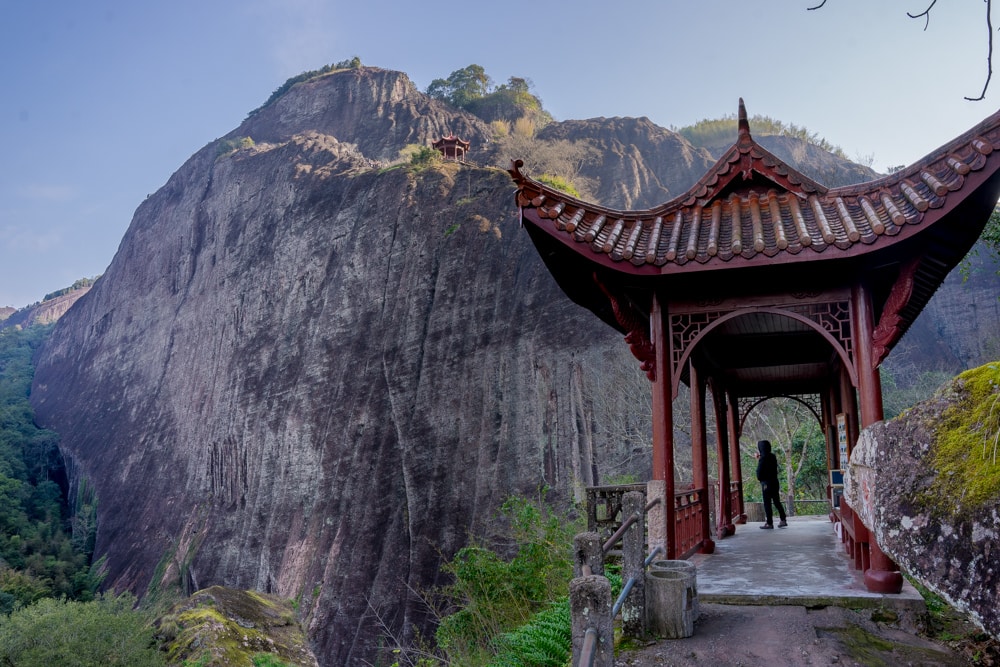
Wuyi Mountains.
Planning Your Visit: A Practical Guide
Planning Your Visit: A Practical Guide to the Wuyi Mountains
The Wuyi Mountains, a UNESCO World Cultural and Natural Heritage Site, present an extraordinary blend of natural beauty and rich cultural heritage, making them a must-visit destination for international travelers. Nestled between Wuyishan City in Fujian Province and Wuyishan Town in Jiangxi Province, this mountainous paradise offers deep canyons, lush forests, and stunning waterfalls. Here’s everything you need to know to make the most of your visit.
Getting There
By Train:
The Wuyi Mountains are well-connected by high-speed rail. The journey from major cities is as follows:
– Shanghai: 3.5 hours
– Hangzhou: 2.5 hours
– Beijing: 7.5 hours
– Xiamen: 3.5 hours
– Fuzhou: 1.5 hours
You can arrive at either Wuyishan North Railway Station or Nanping Railway Station, both approximately 28 km (17 miles) from the scenic area, a quick 25-minute taxi ride away.
By Air:
Wuyishan Airport is located only 12 km (8 miles) from the mountains. However, flights are limited, primarily from Beijing and Guangzhou, so check schedules in advance.
Best Times to Visit
The Wuyi Mountains showcase distinct seasonal beauty throughout the year, making any time a great time to visit:
-
Spring (Late March to May): Ideal for enjoying blooming tea plantations and vibrant flowers, with temperatures ranging from 15 to 25°C (59–77°F).
-
Summer (June to August): Experience lush greenery and a refreshing escape from the heat, but be prepared for temperatures rising to 34°C (93°F). It’s best to avoid outdoor activities during the hottest hours of the day.
-
Autumn (September to Mid-November): The mountains transform into a tapestry of red leaves, offering excellent conditions for hiking and breathtaking views, with temperatures between 15 and 25°C (59–77°F).
-
Winter (Mid-November to Mid-March): Enjoy the sight of fog-covered peaks and the occasional snowfall. Winter is also when hotels offer discounts, and the trails are less crowded. Expect temperatures around 5 to 10°C (41–50°F).
Where to Stay
While Wuyishan is a small city, there are several accommodation options close to the scenic area:
1. Sangu Resort Area:
This area offers the most diverse range of hotels, from luxurious 5-star establishments to budget hostels. It’s located just 3 km (2 miles) from the entrance to Wuyi Mountain Scenic Area.
- Recommended Hotels:
- 5-star: Wyndham Garden Wuyishan
- 4-star: Days Hotel by Wyndham Yinxiang Wuyishan
- Mid-range: Wuyi Mountain Yiqu Xiangsi Alhu Resort Hotel
2. Xingcun Village:
Ideal for those wishing to be close to the Nine-Bend River area, this village is a mere 10-minute walk to the bamboo rafting pier.
- Recommended Hotels:
- 5-star: Wuyi Mountain Jooch Resort Hotel
- 5-star: Jiaye Mountain House
- 4-star: Yuejiuqu Boutique Hotel Wuyishan
Itinerary Suggestions
For a fulfilling experience, a 2-3 day itinerary is recommended. Here’s a suggested 3-day plan:
Day 1:
– Arrive in Wuyishan and explore the One-Line-Sky Scenic Area.
– If time permits, visit the Tiger Hissing Scenic Area before dinner.
Day 2:
– Discover the Da Hong Pao and Water Curtain Cave Area.
– Visit a local tea plantation to sample Wuyi Rock Tea.
Day 3:
– Enjoy bamboo rafting on the Nine-Bend Creek.
– If your schedule allows, hike up Tianyou Peak for panoramic views before saying goodbye.
Activities and Attractions
The Wuyi Mountains offer a range of activities to suit all interests:
- Hiking: Trails vary in difficulty and provide stunning vistas.
- Bamboo Rafting: A serene way to explore Nine-Bend Creek.
- Cultural Sites: Don’t miss Wuyi Palace and the historic tea plantations.
- Wildlife Watching: Keep an eye out for unique flora and fauna endemic to the region.
Practical Tips
- Entrance Fees: Tickets for the Wuyi Mountain National Scenic Area are priced at:
- One Day Pass: 215 yuan (including shuttle bus)
- Two Day Pass: 235 yuan
- Three Day Pass: 250 yuan
-
Additional costs may include bamboo rafting (100 yuan) and visits to specific attractions like the Green Dragon Waterfall (40 yuan).
-
Transportation: Shuttle buses operate within the scenic area, but there are no cable cars. Prepare for some hiking and climbing.
-
Language: While some signs and staff may speak basic English, having a translation app can be helpful.
With its breathtaking landscapes and rich cultural heritage, the Wuyi Mountains promise an unforgettable adventure. Whether you seek relaxation amidst nature or a deep dive into Chinese culture, this destination has something for everyone. Happy travels!
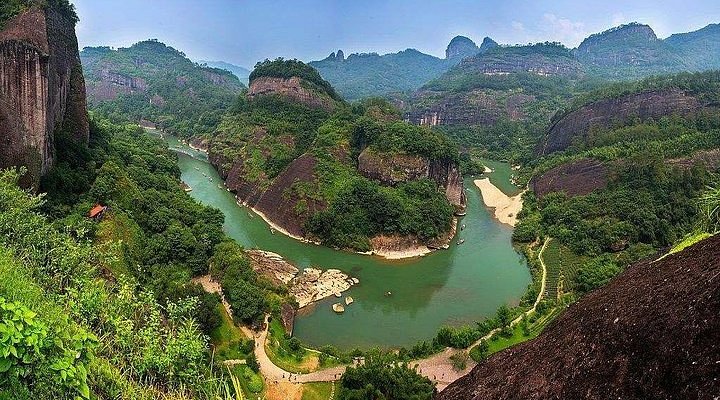
Wuyi Mountains.
Tickets: Prices, Booking, and Tips
When planning your visit to the stunning Wuyi Mountains, understanding ticket prices, booking procedures, and helpful tips will ensure a smooth and enjoyable experience.
Ticket Prices
Entrance to the Wuyi Mountain National Scenic Area is flexible, offering passes for different durations:
- One-Day Pass: 140 yuan + 75 yuan shuttle bus fee = 215 yuan
- Two-Day Pass: 150 yuan + 85 yuan shuttle bus fee = 235 yuan
- Three-Day Pass: 160 yuan + 90 yuan shuttle bus fee = 250 yuan
Additional activities have separate fees:
– Bamboo Rafting: 100 yuan
– Green Dragon Waterfall: 40 yuan
Booking Tickets
Tickets can usually be purchased at the entrance to the scenic area. However, to avoid long queues, especially during peak travel seasons, it’s advisable to book your tickets in advance online through official tourism websites or authorized travel agencies. This ensures you have your entrance secured and can plan your itinerary without delays.
Getting Around
Wuyi Mountains are designed for exploration, and shuttle bus services are available to transport visitors between attractions. While there are no cable cars, the trails are well-maintained and suitable for climbers of all levels.
Tips for a Successful Visit
- Duration: It is recommended to spend 2-3 days in Wuyishan to fully appreciate the natural beauty and cultural heritage. A typical itinerary might look like this:
- Day 1: Arrive and explore the One-Line-Sky and, if time allows, the Tiger Hissing Scenic Area.
- Day 2: Visit the Da Hong Pao and Water Curtain Cave Area, and take a tour of a local tea plantation.
-
Day 3: Enjoy bamboo rafting on Nine-Bend Creek, followed by a climb to Tianyou Peak if you have time.
-
Best Time to Visit: The Wuyi Mountains are beautiful year-round, but visiting during spring (late March to May) or autumn (September to mid-November) will provide you with ideal weather and stunning natural scenery, like blooming flowers or vibrant red leaves.
-
Stay Close: Consider accommodations in the Sangu Resort area or Xingcun Village, which are conveniently located near the scenic area and provide a range of hotel options from luxury to budget-friendly.
-
Stay Hydrated and Prepare for Weather: The mountainous terrain can be challenging, so bring plenty of water and wear suitable clothing and footwear. Be prepared for quick weather changes, especially during early mornings and late afternoons.
By keeping these ticketing details and tips in mind, you can make the most of your adventure in the breathtaking Wuyi Mountains. Enjoy your journey through one of China’s most enchanting landscapes!
How to Get There: A Complete Transportation Guide
Reaching the breathtaking Wuyi Mountains is an adventure in itself, with various transportation options available to ensure a smooth journey for international travelers. The Wuyi Mountains, a UNESCO World Heritage Site located between Fujian and Jiangxi provinces, can be accessed by both air and rail, making it an appealing destination for nature lovers and cultural enthusiasts alike.
By Train
The most efficient way to arrive at the Wuyi Mountains is via high-speed train, which connects major cities across China. Here are some key routes:
- From Shanghai: Approximately 3.5 hours.
- From Hangzhou: Around 2.5 hours.
- From Beijing: Approximately 7.5 hours.
- From Xiamen: Roughly 3.5 hours.
- From Fuzhou: About 1.5 hours.
Upon arrival, you can choose to disembark at either of Wuyishan’s two railway stations: Wuyishan North Railway Station or Nanping Railway Station. Both stations are about 28 kilometers (17 miles) from the Wuyi Mountain Scenic Area, which translates to a 25-minute drive.
By Air
Though less frequent than train services, flights to Wuyishan are available, primarily from Beijing and Guangzhou. The Wuyishan Airport is conveniently located just 12 kilometers (8 miles) from the Wuyi Mountains, allowing for a quick transfer to your destination. Keep in mind that flight options can be limited, so it’s advisable to check availability in advance.
Getting Around
Once you arrive in Wuyishan, transportation to the scenic areas is straightforward. The Wuyi Mountain Scenic Area is well-serviced by shuttle buses that connect various attractions within the park. Here’s a brief overview of the ticketing for the scenic area:
- One Day Pass: 140 yuan + 75 yuan shuttle bus fee = 215 yuan
- Two Day Pass: 150 yuan + 85 yuan shuttle bus fee = 235 yuan
- Three Day Pass: 160 yuan + 90 yuan shuttle bus fee = 250 yuan
Bamboo rafting on the scenic Nine-Bend Creek is a must-do and costs around 100 yuan. Other attractions, such as the Green Dragon Waterfall, will have separate entrance fees.
Local Transportation Options
For those who prefer to explore at their own pace, taxis and ride-hailing services like Didi are available within Wuyishan. Biking and walking are also great ways to soak in the natural beauty and local culture.
Conclusion
With its stunning landscapes and rich cultural heritage, the Wuyi Mountains are easily accessible via trains and flights, making it a destination that should not be missed. Be sure to plan your trip in advance to enjoy everything this natural wonder has to offer! Whether you are looking to hike, raft, or simply bask in the beauty of the surroundings, the journey to the Wuyi Mountains is as rewarding as the destination itself. Safe travels!
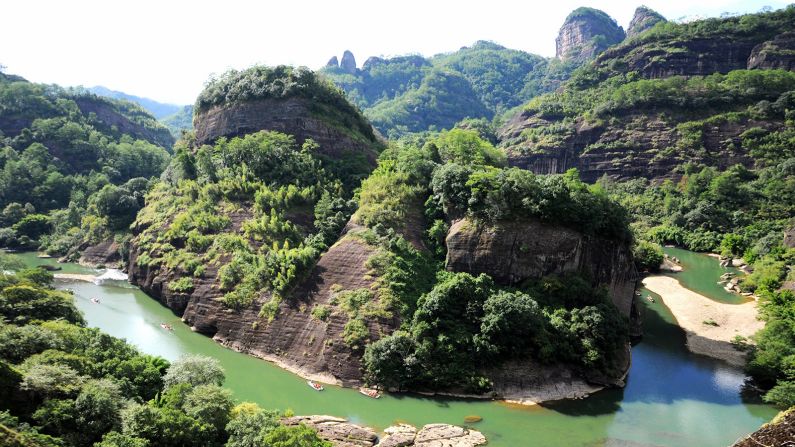
Wuyi Mountains.
Local Cuisine and Accommodation Nearby
Nestled amidst the breathtaking landscapes of the Wuyi Mountains, travelers can indulge in a delightful culinary journey while enjoying comfortable accommodations that cater to various preferences and budgets.
Culinary Delights
The Wuyi Mountains region is renowned for its unique flavors and local specialties. Here are some must-try dishes and dining options:
-
Wuyi Rock Tea (武夷岩茶): This globally acclaimed tea, known for its rich aroma and complex flavors, is a must-try when visiting. You can sample it at local tea houses, especially around the Da Hong Pao Scenic Area, where the famous tea is cultivated.
-
Braised Bamboo Shoots (竹笋炖肉): A local favorite, this dish combines tender meat with fresh bamboo shoots, reflecting the region’s rich agricultural bounty. Many restaurants in the Sangu Resort area offer this delicacy.
-
Stir-fried River Shrimp (河虾炒): Savor the fresh catch from Wuyi’s rivers with this simple yet flavorful dish. Look for eateries near the Nine-Bend River where you can enjoy authentic flavors.
-
Fried Wild Mushrooms (野生蘑菇炒): The lush forests around the mountains yield a variety of wild mushrooms, often featured in local dishes. Seek out small family-run restaurants for the best home-cooked versions.
Accommodation Options
Whether you seek luxury or a cozy inn, Wuyishan offers a variety of lodging options to make your stay comfortable and convenient.
Sangu Resort Area
This area is the most popular choice for visitors due to its proximity to the Wuyi Mountain Scenic Area. Here are some recommended hotels:
-
Wyndham Garden Wuyishan: A 5-star hotel providing modern amenities and beautiful views, perfect for travelers wanting a luxurious stay.
-
Days Hotel by Wyndham Yinxiang Wuyishan: A 4-star option that offers a comfortable experience with easy access to various attractions.
-
Wuyi Mountain Yiqu Xiangsi Alhu Resort Hotel: This mid-range hotel boasts a tranquil setting and excellent service, ideal for relaxation after a day of exploration.
Xingcun Village
For those looking to be closer to the action, Xingcun Village is an excellent choice, especially for early morning excursions.
-
Wuyi Mountain Jooch Resort Hotel: A 5-star option that combines comfort with local charm, just a short walk from the bamboo rafting pier.
-
Jiaye Mountain House: Another 5-star hotel that offers a unique blend of modern luxury and traditional aesthetics.
-
Yuejiuqu Boutique Hotel Wuyishan: A charming 4-star hotel that provides a cozy atmosphere and easy access to nearby attractions.
In Summary
The Wuyi Mountains not only offer stunning natural beauty but also a rich gastronomic experience and comfortable accommodations to enhance your visit. Whether you are enjoying a cup of Wuyi Rock Tea or savoring local delicacies, your experience in this UNESCO World Heritage site will surely be memorable.
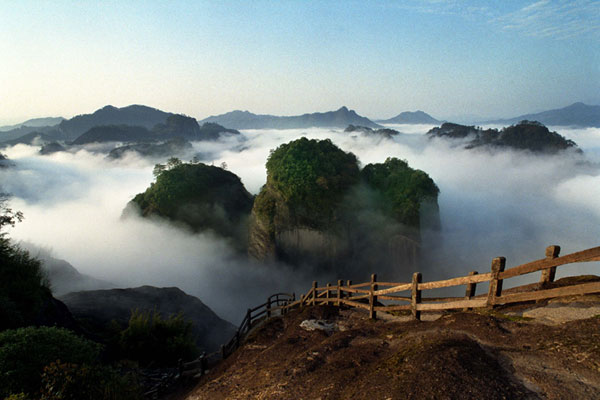
Wuyi Mountains.
Frequently Asked Questions
-
What is the best time to visit the Wuyi Mountains?
The Wuyi Mountains are stunning year-round, with each season offering its own charm. Spring (late March to May) is ideal for blossoming flowers and tea plantations. Summer (June to August) showcases lush greenery, while autumn (September to mid-November) is famous for beautiful red leaves. Winter (mid-November to mid-March) offers foggy scenery and fewer crowds. -
How do I get to the Wuyi Mountains from major cities?
You can take a high-speed train to Wuyishan from cities like Shanghai (3.5 hours), Hangzhou (2.5 hours), Xiamen (3.5 hours), and Fuzhou (1.5 hours). There are two railway stations in Wuyishan: Wuyishan North and Nanping, both about a 25-minute drive from the scenic area. Flights are available but less frequent, mainly from Beijing and Guangzhou. -
What are the main attractions in the Wuyi Mountains?
The Wuyi Mountains feature diverse attractions, including the Nine-Bend River, One-Line-Sky, Tiger Hissing Peak, Tianyou Peak, and the Water Curtain Cave. Each area offers unique experiences like hiking, bamboo rafting, and exploring tea estates or cultural heritage sites. -
How can I plan my visit to the Wuyi Mountains?
A typical visit lasts 2-3 days. You can purchase a 1 to 3-day entrance ticket to the Wuyi Mountain National Scenic Area. Plan your itinerary around the main scenic areas and consider activities like bamboo rafting or visiting tea plantations. A suggested 3-day itinerary includes exploring One-Line-Sky, Da Hong Pao, and bamboo rafting on the Nine-Bend River. -
Where should I stay while visiting the Wuyi Mountains?
The best accommodation options are in the Sangu Resort area and Xingcun Village, both close to the scenic area. Sangu Resort offers a variety of hotels from luxurious to budget-friendly, while Xingcun is ideal for early morning activities like bamboo rafting. -
Are there any recommended tours available?
Yes! There are curated tours, such as the 3-Day Wuyishan Refreshing Tour with a tea experience or a 5-Day tour that includes Xiamen and the Tulou earthen buildings. Many tours can be tailored to fit your interests and schedule. -
What should I pack for a trip to the Wuyi Mountains?
Depending on the season, pack comfortable hiking shoes, breathable clothing, and a light jacket for cooler evenings. In summer, remember sun protection, and in winter, include warmer layers. Don’t forget essentials like a reusable water bottle and a camera to capture the breathtaking landscapes! -
Is it easy to navigate the Wuyi Mountains?
Yes, the Wuyi Mountains are accessible and user-friendly. There are shuttle bus services between attractions, and the hiking trails are well-marked. While there are no cable cars, the mountain trails are generally easy to climb, making it suitable for travelers of all fitness levels.
Final Thoughts on Your Trip
As your journey through the breathtaking Wuyi Mountains draws to a close, take a moment to reflect on the myriad of experiences you’ve gathered in this UNESCO World Heritage Site. From the serene bamboo rafting along the Nine-Bend Creek to the awe-inspiring views atop Tianyou Peak, each moment spent here invites you to connect deeply with nature’s artistry. The rich tapestry of flora and fauna, coupled with the rich cultural heritage encapsulated in ancient temples and historic tea estates, creates an unforgettable backdrop for adventure and tranquility alike.
Whether you’ve marveled at the majestic cliffs, enjoyed the delicate flavors of Wuyi Rock Tea, or simply basked in the peace of this untouched landscape, the Wuyi Mountains leave an indelible mark on your soul. As you prepare to depart, carry the spirit of these mountains with you—a reminder of the beauty found in nature and the stories waiting to be discovered.
In every season, the Wuyi Mountains beckon with a unique charm, ensuring that your memories will forever be vibrant and alive. Until your next adventure, may the whispers of the winds and the rustle of leaves accompany you, igniting a desire to explore more of the world’s hidden gems. Safe travels!